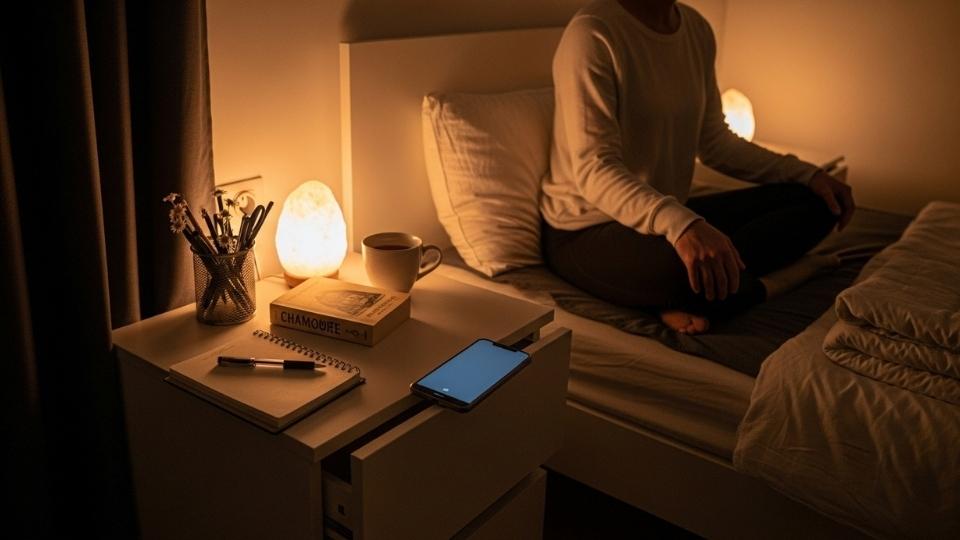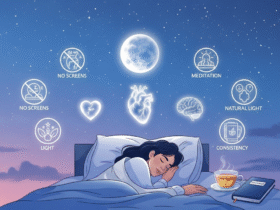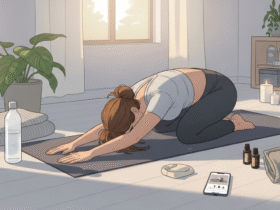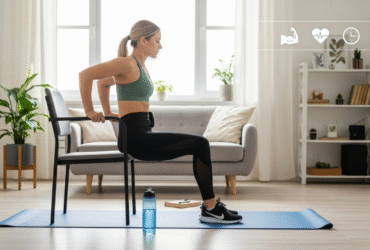It’s 11:47 PM. You’re exhausted, but your phone is still in your hand, glowing in the dark. Your thumb continues to swipe carelessly, moving from a reel, to a message, to a meme—and before you know it, it’s well past midnight.
You close your eyes, but your brain refuses to shut down. It’s restless. Anxious. Alert. Your mind won’t switch off even though your body is pleading for rest. Sound familiar?
In today’s technology-driven world, we’re all connected to screens, especially in the evenings. While scrolling may seem like an innocent way to wind down, it’s silently robbing you of peaceful sleep. If you’re tired of feeling tired, this guide is for you.
Cutting down on screen time and improving your sleep is not only realistic but entirely doable. Let’s explore how to make it happen.
Why It’s Difficult to Sleep in Front of the Screen (The Science Explained)
It’s no secret that screens don’t help with sleep. But why exactly is that?
There are two main reasons: light and stimulation.
1. Blue Light Disrupts Melatonin
Our body follows a natural cycle known as the circadian rhythm, which helps us stay alert during the day and fall asleep at night. As night falls, your brain releases melatonin, a hormone that signals to your body that it’s time to relax and sleep.
But here’s the problem: screens emit blue light, which tricks your brain into thinking it’s still daytime. This slows down melatonin production, keeping your brain active—even when your body is physically tired and ready for rest.
2. Screens Over-Stimulate the Brain
It’s not just the light; it’s the constant stimulation. Whether you’re reading news, scrolling through social media, or checking emails, your brain remains in a heightened, alert state. Instead of relaxing, you’re constantly absorbing, processing, and reacting to information.
Even though you’re lying in bed, trying to rest, your thoughts aren’t resting. This mental stimulation makes it harder for your brain to wind down, leading to lower-quality sleep, a longer time to fall asleep, and even the development of insomnia.
Red Flags That Your Screen Time Is Interfering with Your Sleep
Sometimes, we don’t even notice that our technology habits are harming us. Here are some obvious signs that your screen use is negatively impacting your sleep:
Signs Your Screen Time Is Affecting Your Sleep:
- It takes you more than 30 minutes to fall asleep most nights.
- You wake up in the middle of the night and immediately reach for your phone.
- You feel tired, even after a full night’s sleep.
- You experience vivid or restless dreams.
- You have trouble concentrating or staying energized during the day.
- You rely on caffeine to stay awake in the morning.
- You feel anxious or irritable when you’re not using your device.
If you find yourself saying “yes” to more than a couple of these, it might be time to reassess how you’re spending your screen time at night. Your habits may be silently interfering with your sleep quality
How to Cut Screen Time and Improve Sleep

Now that we know how screens are affecting our sleep, here are some simple steps you can take to reduce screen time and improve your rest:
1. Set a Screen Curfew
Try to stop using screens 30-60 minutes before bedtime. Instead, engage in relaxing activities like reading a book, journaling, or practicing relaxation techniques.
2. Use Blue Light Filters
If you must use your phone or computer before bed, turn on night mode or install a blue light filter to minimize the impact on melatonin production.
3. Create a Sleep-Inducing Environment
Make your bedroom a sanctuary for sleep:
- Keep the room dark, cool, and quiet.
- Use a white noise machine or earplugs if external noise is an issue.
4. Practice Relaxation Techniques
Incorporate mindfulness, meditation, or deep breathing exercises into your nightly routine. These practices help calm the mind and prepare it for sleep.
5. Avoid Caffeine and Heavy Meals Before Bed
Avoid consuming caffeine or heavy meals late in the day, as they can interfere with your ability to fall asleep.
Why Reducing Screen Time Improves Sleep Quality
Reducing usage of screens, particularly at night does not only make you sleep quicker, but it also leads to improved quality sleep. It in fact enhances the quality of your sleep in several aspects:
Longer Sleep Rhythms: The less you stimulate your brain in the hours prior to going to bed the deeper sleep stages your brain falls into.
Better Melatonin CirculationWhen you are not exposed to blue light in the late evening hours, your body actively discovers melatonin, making you fall asleep at the right times.
Reduced Night Induced Anxiety: Decreasing your screen time will help you to avoid the stressful cycle that the evening doomscroll spin can create.
Wake up feeling more alert: Your brain spends less time feeling overstimulated at night when you avoid activities that stimulate your brain before going to bed and with this feeling, you should feel better in the morning.
A brief analysis of how screen habits affect on your body goes thus:
How Nighttime Screen Use Affects Your Sleep
| Screen Habit | Impact on Sleep | Sleep Benefit of Reducing It |
|---|---|---|
| Using phone/laptop 30 mins before bed | Delayed melatonin release, longer time to fall asleep | Easier, quicker sleep onset |
| Watching TV or YouTube in bed | Mental stimulation, light exposure disrupts REM sleep | Deeper, uninterrupted sleep cycles |
| Scrolling social media in the dark | Anxiety, emotional overstimulation | Calmer mind, improved emotional regulation |
| Keeping phone on all night | Interruptions from notifications or checking habits | Less waking, better sleep efficiency |
When To Stop Using Screens For Best Sleep
You don’t have to become a tech-free person, but timing is key. Many professionals recommend a digital sunset, or a designated time to turn off your screens to allow your brain to wind down and prepare for sleep.
Best Time to Disconnect: 60-90 Minutes Before Bedtime
Turning off your screens 60-90 minutes before bed gives your mind the time to transition from the active mode of the day into the restful mode of the night. During this time, it’s helpful to replace screen-heavy activities with those that support relaxation and rest.
Healthy Alternatives to Screen Time:
- Reading a physical book
- Doing light stretching or yoga
- Journaling your thoughts
- Listening to soft music or a calming podcast
- Preparing your bedroom for sleep (turning down the lights, fluffing the pillows, etc.)
If you typically fall asleep at 11 PM, try making a goal of turning off your devices at 9:30 PM. The regularity of such a routine signals to your body, “It’s time to sleep.”
10 Practical Tips to Cut Screen Time Before Sleep
You don’t have to go cold turkey. Instead, aim for small, consistent changes that will be more sustainable and effective over time. Here are 10 practical tactics to help reduce screen time before bed:
1. Install a Screen Curfew
Set a specific time—9:00 PM, for example—and make it non-negotiable. Use an alarm or reminder to enforce this boundary every day.
2. Do Not Bring Your Phone to Bed
Temptation is strong when your phone is on your nightstand. Charge your phone in a different room and use a basic alarm clock instead.
3. Use Night Mode or Blue Light Filters
Most smartphones and laptops have a night shift mode built-in, which adjusts the screen’s color temperature to reduce blue light. While not perfect, it’s better than full exposure.
4. Wear Blue Light Glasses
If you absolutely need to use screens at night (e.g., for work), invest in blue light blocking glasses to reduce the impact on your melatonin production.
5. Switch to an eBook or Paperback
If you prefer reading, opt for a physical book instead of an eBook. Reading can relax your brain and signal that bedtime is approaching. Keep it light and soothing—no need for heavy, intense material.
6. Develop a Calm Bedtime Routine
Establish a calming evening routine:
- Dim the lights
- Brush your teeth
- Do some gentle stretches
- Light a candle or drink herbal tea
These small rituals will replace the noise of the internet with comfort and relaxation.
7. Track Screen Time with Apps
Use apps like Digital Wellbeing (Android) or Screen Time (iOS) to track your screen usage. These apps provide insight into how much time you’re spending on screens and when.
8. Write, Don’t Swipe
Before reaching for your phone, try journaling for five minutes. This mental exercise helps clear your thoughts and provides a sense of release, making it easier to sleep.
9. Create a Charging Station Away from Your Bed
Set up a charging station in another room or across the room from your bed. When you can’t see your devices, you’ll be less tempted to pick them up.
10. Use Calming Apps the Right Way
If you’re reluctant to ditch tech entirely, consider using apps like Calm, Insight Timer, or Opal. Just make sure to use them purposefully, not as a means to add more screen time.
How to Develop a Screen-Free Evening Routine (Step-by-Step)
Without a structured bedtime routine, your brain won’t know it’s time to relax. This lack of routine is one of the main reasons people struggle to fall asleep—your mind hasn’t switched to night mode when your body is already ready for rest.
Here’s how you can build your own non-screen bedtime routine that feels enjoyable, not restrictive:
Step-by-Step Guide:
- Set a consistent time to start winding down each night (e.g., 9:00 PM).
- Turn off screens 60-90 minutes before bed.
- Replace screen-heavy activities with calming activities like reading, journaling, or listening to soothing music.
- Dim the lights to signal to your body that it’s time to relax.
- Create a calm environment by preparing your bedroom—fluffing your pillows, adjusting the room temperature, and adding soft lighting.
- Engage in a relaxing ritual like stretching, breathing exercises, or drinking herbal tea.
- Make this routine consistent every night to send a signal to your brain that it’s time to rest.
By gradually incorporating these steps into your nightly routine, you’ll help your body and mind unwind naturally, leading to better sleep.
Step 1: Set a Digital Sunset Time
Begin by committing to turning off your screens one hour before bed. Over time, you can extend this to 90 minutes if possible. To make it easier, set a reminder or automate the process, for example, by using Focus Mode on your iPhone to limit screen use.
Step 2: Practice a Wind-Down Activity
Instead of scrolling through your phone, engage in relaxing activities that help you unwind. Choose from the following:
- Light reading (preferably on paper, not an e-reader)
- Gentle yoga or stretching
- Journaling your thoughts
- Body scan or deep breathing exercises
- A warm shower or a calming skincare routine
These activities help signal to your body that it’s time to relax and prepare for sleep.
Step 3: Set Up Your Environment
Your sleep environment plays a big role in preparing your body for rest. Here’s how to make your space conducive to sleep:
- Dim the lights to encourage melatonin production
- Adjust the room temperature to a comfortable, cool setting
- Declutter your space to create a calming environment
Your surroundings should send a clear message to your brain: this is a place for rest, not for work or stimulation.
Step 4: Practice Mindfulness or Gratitude
Before you turn in for the night, take a moment to reflect on your day. This helps clear any lingering emotional tension. You can practice:
- Mindfulness: Simply observe your thoughts and let them pass without judgment.
- Gratitude: Write down something you’re thankful for or something you’re releasing from the day.
This small practice helps your mind transition into a calm state and prepares you for a restful night
Nighttime Routine Timeline
| Time | Activity |
|---|---|
| 9:00 PM | Digital sunset — all screens off |
| 9:10 PM | Light hygiene + skincare |
| 9:20 PM | Stretching or breathing exercises |
| 9:30 PM | Journal 3 thoughts or gratitudes |
| 9:45 PM | Read a chapter of a book |
| 10:00 PM | Lights off, sleep |
Tackling the Emotional Side of Screen Habits
Let’s be honest: reducing screen time isn’t just about changing your behavior—it’s about addressing the emotional triggers that keep you hooked. We don’t scroll at night because it’s productive; we scroll because we’re seeking to fill an emotional need. Whether it’s loneliness, anxiety, or apathy, your phone often becomes a place of escape.
What if, instead, we could use screens as a tool for rest and relaxation? Here are the most common emotional triggers behind excessive screen time and how to cope with them in a healthier way.
1. Boredom → Deliberate Idleness
There’s no harm in boredom. In fact, boredom can be a gateway to the present moment. Instead of reaching for your phone to fill the space, try experiencing the discomfort of boredom. Often, it’s when our brains are craving something quieter, something more restful.
How to cope:
- Embrace idleness. Let boredom teach you to appreciate stillness.
- Engage in activities that don’t require stimulation, like daydreaming or observing your surroundings.
2. Loneliness → Connection Rituals
Scrolling late at night is often driven by the need for connection. You’re not necessarily looking for content; you’re seeking connection—something to soothe feelings of loneliness.
How to cope:
- Instead of reaching for your phone, try journaling your thoughts or writing unsent letters to loved ones.
- Consider setting aside time for prayers or moments of reflection. These can foster a sense of connection and peace without needing digital validation.
3. Fear → Grounding Techniques
When your mind races with fear or anxiety, it’s easy to grab your phone for distraction. But this can keep your brain in a heightened, alert state, which makes it harder to wind down.
How to cope:
- Practice grounding exercises, such as the 5-4-3-2-1 technique (name 5 things you can see, 4 you can hear, 3 you can touch, 2 you can smell, and 1 you can taste).
- Journal your thoughts to clear your mind. This helps release emotional tension and prepares you for rest.
4. FOMO → Mindful Media Boundaries
Fear of missing out (FOMO) can keep you glued to your phone, even late at night. But you can remind yourself that peace is more important than staying constantly updated.
How to cope:
- Set media boundaries. Remind yourself that peaceful sleep is a powerful choice over constant social updates.
- Practice mindfulness when engaging with media, ensuring it’s something that truly benefits your mental state rather than fuels anxiety.
Relaxing Alternatives to Pre-Bed Screens
When you find true pleasure in alternatives to screen time, it becomes easier to cut down. You don’t need to force yourself into silence or meditate for hours. Here are some soothing activities to help you unwind without screens:
Soothing Replacements to Pre-Bed Screen Time:
- Reading a magazine or novel
- Journaling your thoughts, emotions, or dreams
- Gentle yoga asanas or pranayama (breathing exercises)
- Coloring books or solving puzzles
- Drinking herbal tea while listening to soft music
- Tidy up—light cleaning or setting plans for the next day
- Listening to white noise or natural sounds to calm your mind
These activities help signal to your nervous system that it is safe and relaxed, preparing your body for rest.
What If You Need to Use Screens at Night?
Sometimes, using screens at night is unavoidable. Whether you’re a parent behind on chores, a work-at-home employee, or a student meeting a deadline, it’s not always possible to go completely screen-free. In such cases, focus on damage control.
Here’s how to minimize the negative impact of screens at night:
1. Control Brightness with Night Shift + Low Brightness
Always use night mode or a blue light filter on your phone or device in the evening. Lower the brightness manually and avoid using bright white backgrounds to minimize blue light exposure.
2. Wear Blue Light Glasses
Blue light-blocking glasses can help protect your melatonin production. They’re especially helpful when you need to use screens under artificial lighting.
3. Stay Away from Over-Stimulating Content
Avoid high-energy content such as fast-paced videos, emotionally charged news, or anything that makes your brain overactive. Opt for calming content with slow visuals or gentle music to soothe your mind.
4. Take Eye Breaks Every 20 Minutes
Follow the 20-20-20 rule: After every 20 minutes of screen use, take a 20-second break and focus on something 20 feet away. This helps relieve eye strain and resets your focus.
For Parents: Creating Screen Boundaries at Home
As a parent, you know how challenging it can be to enforce screen time rules, especially with your own responsibilities. However, it’s not just what you say that matters when it comes to modeling healthy behaviors—it’s what you do.
Here are some workable family strategies to promote healthier screen habits:
1. Design a Whole-House Digital Sunset Rule
Set a family-wide time to turn off all screens each day. Start with 30 minutes before bedtime and gradually increase the time. Make this a shared family habit rather than a punishment.
2. Create an Outside Charging Station for Bedrooms
Set up a charging station outside of the bedroom to keep devices out of the room at night. This ensures a device-free space, which can significantly improve everyone’s sleep quality.
3. Substitute Family Rituals for Screens
Replace screen time with calming, offline activities such as:
- Bedtime stories
- Journaling together
- Playing card or board games
- Listening to audio stories as a family wind-down activity
These rituals can help foster family connection and promote relaxation before bed.
4. Keep Communication Open
Instead of using strict prohibitions, explain to your children why sleep is important and how screens can negatively affect their body and mind. Involve them in finding solutions together.
Tracking Progress: Measuring Positive Changes Without Obsession
Making small, sustainable changes is key to cutting back on screen time. Here’s how you can track your progress without obsessing over perfection:
1. Look at Screen Time Reports Weekly
Most phones monitor screen time. Instead of focusing on daily changes, check weekly reports to track your screen usage. Celebrate each 10-minute decrease. Small victories lead to real change.
2. Maintain a Sleep Diary
Track your sleep by noting:
- The time you turn off your screens
- How quickly you fall asleep
- Your sleep quality (rate on a scale of 1-10)
- Your mood upon waking
This can help you identify patterns and see the impact of your new habits.
3. Reward Yourself for Progress
Whenever you maintain your screen-free routine, reward yourself—not with more screen time, but with an offline activity you enjoy. Whether it’s a walk, a favorite breakfast, or starting a new book, rewarding your progress helps reinforce your efforts.
Mistakes to Avoid While Cutting Back on Screen Time
Some strategies may sound good but can backfire quickly. Here’s what to avoid:
1. Cold Turkey and No Replacements
Don’t just eliminate screens—replace them with restful, offline activities. Otherwise, you may relapse into screen habits quickly.
2. Making “Exceptions” Every Night
If you keep excusing yourself with, “It’s only one more video” or “I’ll just reply to one more message,” you’re not helping your habit. Stick to your plan and avoid spontaneous exceptions.
3. Using Sleep Sounds, But Still Browsing
Many people use apps for sleep music but end up scrolling through their phones while the app is open. If you use these apps, turn them on, then put the phone down to avoid the temptation to browse.
4. Evaluating Progress with Perfection
Perfection isn’t the goal. Reducing screen time is about progress, not eliminating all screens. Aim for improvement—7 nights out of 10 without screens at night is a success.
Expert Opinions Supporting Screen-Free Sleep Habits
Many experts agree on the negative effects of using screens before bedtime. According to The Sleep Foundation, as little as 30 minutes of blue light exposure at night can delay melatonin production by up to 90 minutes.
Dr. Christopher Winter, a neurologist and sleep specialist, also emphasizes that even small adjustments—such as setting your phone aside 30 minutes before bed—can significantly improve sleep latency (the time it takes to fall asleep) and sleep quality over time.
Mental health therapists also recognize the importance of digital hygiene, especially for people dealing with anxiety, stress, or sleep disorders.
Conclusion: Sleep is Essential for Health, Not a Luxury
The key is not about disconnecting from technology entirely. It’s about reconnecting with yourself—your breath, your mind, your calm. Sleep is a biological necessity, not a luxury.
Start small: maybe tonight, you only disconnect for 15-30 minutes before bed. Light a candle, listen to your breath, and skip scrolling through social media. You can even jot down a few thoughts in a journal and skip TikTok.
These small steps rewire your brain. In time, you’ll no longer be chasing sleep. You’ll simply begin to get it.















Leave a Reply